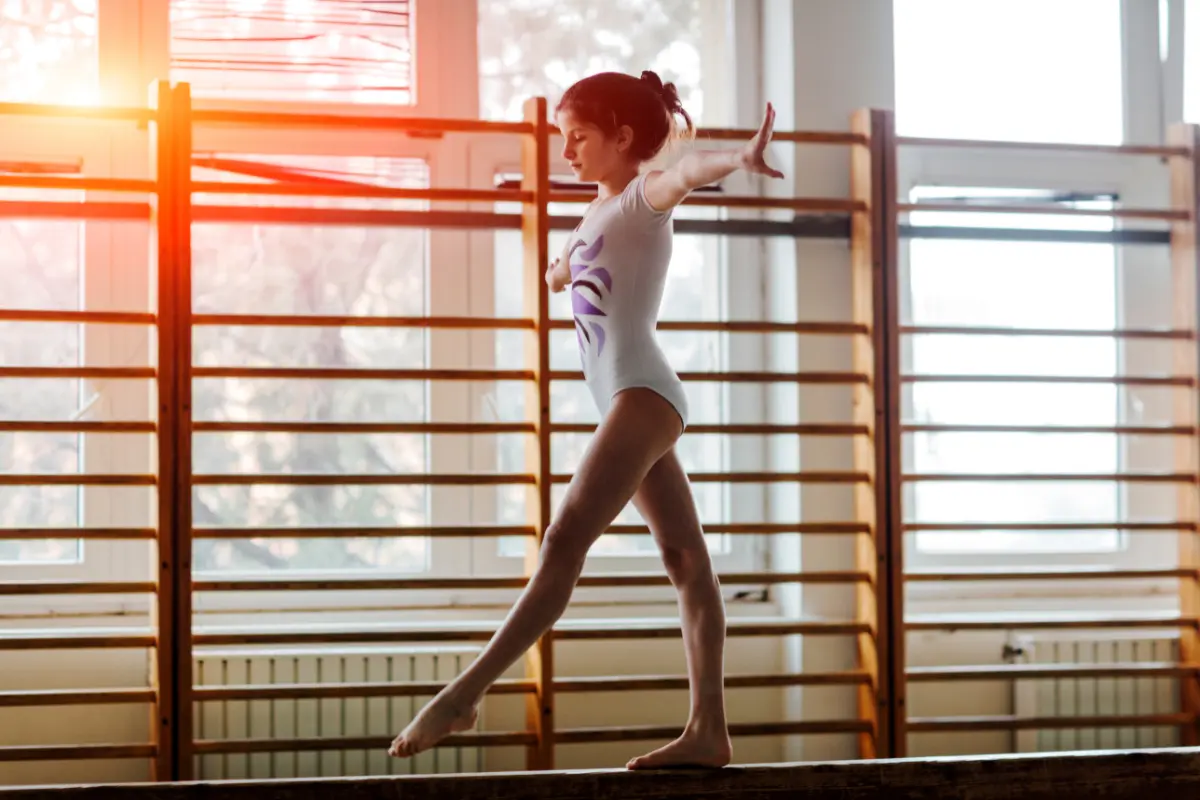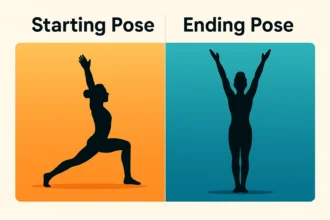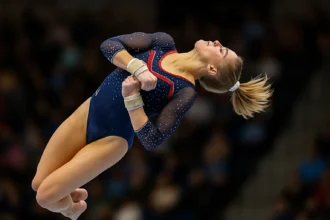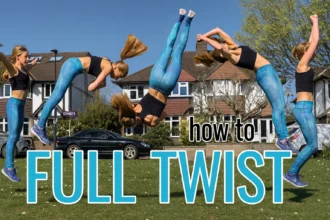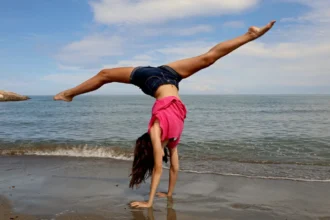Beam routines are key elements in artistic gymnastics competitions. Each level from 1 to 5 has specific requirements for the skills gymnasts need to perform. Here is a guide to understanding the basic structure and elements of the beam routines for each level.
Level 1 Beam Routine
The balance beam routine at Level 1 can be a fun and challenging skill to master.
1. The Salute & Mount
Start by standing at one end of the balance beam. The routine begins with a salute, followed by a jump to front support. This mount involves getting your body in a straight, stable position with your arms lifted and legs in front. Be sure to execute this jump with control, aiming for a smooth transition from the ground to the beam.
2. Straddle Sit to Tuck
Once you’re in front support, the next move is a straddle sit. Swing your dominant leg over the beam and place your legs in a split position. Your arms should come up to a crown position, creating a smooth line from your shoulders to your fingertips. This is followed by a tuck sit, where you pull your legs up into a squat position with your arms still in the crown.
Pro Tip: Keep your legs tight and your arms strong to maintain balance. A clean straddle position is key to setting up the next part of the routine.
3. Tuck Squat to Lever
From the tuck sit, you’ll move into a lever position, which requires your body to be parallel to the beam. Make sure that your hips are squared with the beam—avoid opening them too much, as this will throw off your alignment. Push off the beam with your arms and return to the tuck squat position.
4. Relevé & Step to Position
From the squat, rise into a relevé (standing on the balls of your feet) with your arms in a crown position. Keep your posture tall and stable as you transition into a Plié (POS) position. Step forward with your dominant leg, keeping your knee aligned with your hip and toe pointed.
Tip: The knee should be at the level of the hip, and your body should maintain a straight line, avoiding any exaggerated arm movements.
5. Stretch Jump
From the Plié, you’ll go into a stretch jump. This movement requires you to push off the beam with your arms reaching upward. The key to a successful jump is to keep your toes pointed and your body fully extended. Upon landing, return to the relevé position with your arms in a crown.
6. Arabesque Tap
Next, from the relevé, lower your arms to a T position and extend your non-dominant leg behind you into an Arabesque. This position is a beautiful line that should be held for a moment, followed by a tap of your foot back to the beam. Make sure the arms stay in a T, and the tap is smooth and controlled.
7. Leg Swing & Step Lock
After the Arabesque tap, the next part of the routine focuses on a leg swing. Start by stepping forward with your non-dominant leg, swinging the opposite leg up and then stepping onto it. Once you’ve made the initial step, swing the other leg and place it on the beam as well. From here, lock your legs in position, keeping your dominant leg in front and arms lifted.
8. Choreography: Step Back & Reach
The choreography section of this routine is fun and expressive. Start by stepping back with your dominant leg, keeping the other leg in front. Then, drop into a flat-footed position. The arms are important here, as you will bend them slightly and push forward in a fluid motion. The goal is to create a controlled, graceful movement.
9. Side Handstand Dismount
To finish off the routine, you’ll prepare for the side handstand dismount. First, step back and get into a forced arch with your front foot, followed by another step back to push and pull through your arms. Finally, you’ll point your body and go down into a kneeling position, setting up for a smooth handstand to finish.
Tip: It’s important to maintain control throughout the dismount, with clean and sharp movements to showcase strength and stability.
Level 2 Beam Routine
The Level 2 balance beam routine introduces new elements that build on the fundamentals learned in Level 1. This routine requires control, fluidity, and precision, with a mix of mount techniques, poses, jumps, and preparation for more advanced skills.
1. Mounting the Beam
To start, the mount begins with a jump into front support, just like on the bars. The goal here is to keep your hips flat, eyes forward, shoulders rounded, and legs tight together. Your happy leg (dominant leg) will swing over the beam. It’s crucial that the leg swings straight with pointed toes and tight legs—avoid bending your knees here.
Once you land on the beam, place your hands on the beam, lean back, and lift your legs into a pike position. Both legs should remain straight, and you want to avoid resting your heels on the beam. Instead, push through the top of your feet to keep them pointed. This creates a clean line and prepares you for the next part of the routine.
2. Crown Position and Transition
After establishing your pike position, you’ll transition into a crown position.
Raise your arms and step forward onto your non-dominant leg (the leg not used to kick over the beam). Keep your dominant leg in front while your non-dominant leg stays behind.
At this point, you’ll rise onto the tips of your toes, entering relevé. Make sure your body is straight, with no bent knees. Your arms should be in a gentle crown position, forming a soft curve above your head.
3. Passe and Relevé
Next, you’ll move into a passe. The idea here is to lift your non-dominant leg up so that the knee is at hip level, creating a straight line with your body. The knee should be parallel to the beam, and the foot should remain pointed.
Push through the back of your foot, transferring the pressure from your heel to your toes, and then rise into relevé. This will create a clean, balanced position on the beam. Afterward, step back into relevé to transition into the next part of the sequence.
4. Plie and Jump Sequence
This section is focused on building strength for future jumps:
- Landing: After the jump, land back into crown position, then return to plie, prepare, and repeat the sequence.
- Plie: Start by performing a plie (bending your knees) while keeping your heels flat on the beam and shoulders down. Your body should form a straight line from your shoulders to your hips to your heels.
After stabilizing, rise into relevé (on your toes) and perform another plie. Then, move into a stretch jump, ensuring your body fully extends as you jump. The arms should move fluidly from down to up and back again to set the rhythm.
5. Sharp Movements and Arabesque
The next part of the routine incorporates sharp, precise movements. After finishing the plie and jump sequence, you’ll transition into an Arabesque.
This involves tapping the back foot behind you, keeping the leg straight and engaged, and slicing your arms outward to the sides. As you extend your leg, remember to maintain control and avoid letting your foot relax on the beam. Squeeze your glutes to keep the leg straight and strong.
This transition flows into the Arabesque tap—a sharp movement where you lift your leg, hold briefly, and then tap the beam with your foot. This prepares you for future leaps and adds a graceful touch to your routine.
6. Turn Preparation
Moving on, you’ll start preparing for a turn. Begin by stepping onto the silly leg (your non-dominant leg), and lock your happy leg (dominant leg) behind it. This position prepares you to rotate on the beam while staying balanced and focused. As you get ready for the turn, focus on keeping your chest up and not dropping it—this is key to executing clean spins in the future.
7. Step Back Pose
Now, you’ll incorporate a step back pose. Step back with your dominant leg, keeping your shoulders aligned. The arms will follow a sequence: first down to your sides, then up in front of you, before settling into a pose with one hand placed on top of the other. This sharp movement leads into the dismount.
8. Dismount
Finally, it’s time to finish with a clean dismount. After preparing your body for the turn and executing the step back pose, you’ll transition into a side handstand dismount. Hold your arms in the crown position, and perform the dismount with a strong, controlled exit from the beam. The key here is to ensure your body remains straight and you land with confidence, finishing with a salute.
Level 3 Beam Routine
The Level 3 balance beam routine marks a significant step up in both complexity and precision for gymnasts. It introduces more advanced movements such as handstands, pivot turns, and more intricate jumps.
1. The Mount: Jump to Front Support
Your routine starts with a jump to front support on the beam, which sets the tone for the rest of your performance. Precision is key here.
- Key Actions: Jump onto the beam, ensuring that your arms are straight and your non-dominant leg comes up to your bottom. Keep your knees together and your toes pointed.
- Transition to the Crown: Once you’re in front support, place the middle part of your foot on the beam and swing your dominant leg through. Bring your arms down, making sure to keep them supple (not sharp). Turn your hands onto the beam, and place your dominant knee down onto the beam.
Tip: Keep your foot pointed until it touches the beam to avoid a flexed foot early in the movement.
2. Crown Pose and Arm Movement
Once you transition to front support, move into the crown position.
- Arm Movement: Push your non-dominant arm out and keep your arm movements soft and controlled. As you come into the crown, keep your chin up and your eyes focused down the beam.
- Arm Transition: Bring your arms down, then swoop them up into a V position, pressing your shoulders down and elongating your neck.
Tip: Keep your arm movements smooth and encourage yourself to maintain rounded, graceful arms, like a “ballerina” shape.
3. Leg Lift and Arm Placement
Once in the crown position, you’ll perform a controlled leg lift with your dominant leg.
- Key Actions: Lift your dominant leg forward in a soft, controlled movement (not a kick). As you lift your leg, bring your arms down, then gently push them outward, finishing with a soft wrist flick.
- Tip: Keep your non-dominant leg straight and balanced as you lift the dominant leg. Avoid bending the non-dominant leg.
Tip: Make sure the movement is smooth, not jerky, and ensure your arms stay aligned with your body to maintain balance.
4. Handstand Preparation
Now, it’s time to prepare for the handstand. Start by performing a plié with your non-dominant leg straight.
- Handstand Execution: Use a lunge or a mountain climber to get into the handstand position. Once you’re in the handstand, hold it vertically for a brief moment before stepping back down.
Tip: You don’t need to be perfectly vertical, but aim to get as close to a full vertical hold as possible.
5. Back Lunge and Arm Cross
After the handstand, you’ll perform a back lunge with your non-dominant leg coming forward.
- Arm Movement: Cross your arms in front of your body, keeping them soft and supple as you prepare for the next part of the routine.
- Key Action: Lift the knee of your non-dominant leg to your knee. Keep your movements controlled and smooth.
Tip: The transition should be fluid, with relaxed arms. Keep your shoulders engaged and avoid stiffness.
6. Relevé and Turn Position
Next, you’ll move into a relevé lock position to prepare for the turn.
- Turn Setup: Step into a position where your dominant foot is in front. Your arms should frame your body in a rounded shape, ensuring that your shoulders are pressed down and your neck is long.
Tip: Maintain a rounded shape with your arms and body to avoid sharp angles.
7. Heel Snap Turn
Now it’s time for the heel snap turn.
- Key Actions: Start with your heel on the beam, press into relevé, and snap your heel around. Close your arms into a “beach ball” position, then complete a quick pivot before your foot returns to passe.
- Body Alignment: Keep your body upright, shoulders pressed down, and neck elongated throughout the turn. Ensure your arms stay in a rounded position.
Tip: Keep your arms soft yet controlled. Avoid dropping your shoulders or losing your alignment during the turn.
8. Jump Sequence: Plie and Stretch Jumps
Next, you’ll perform two consecutive jumps, with a plie before each jump.
- Key Actions: As you jump, keep your chest lifted and your shoulders over your hips. Your feet should come together in mid-air before landing.
- Arm Movement: Your arms should move smoothly from down to up, then back down and up again during the jumps.
Tip: Maintain good posture throughout the jumps and avoid collapsing your chest as you land.
9. Leap Preparation and Execution
You’ll now practice a leap preparation sequence with a deep plié.
- Key Actions: Leap and land in a relevé position, with arms extended out to the side in a “T” shape. This will help you transition smoothly into a turn.
- Tip: Keep your chest open and your shoulders aligned during the leap, focusing on balance and control.
10. Pivot Turn and Weight Transfer
Next, perform pivot turns with a smooth weight transfer from one foot to the other.
- Key Actions: Focus on keeping your body upright and controlling your weight transfer during the turn. Your back foot should bear most of the weight to reduce wobbles.
- Tip: Stay high in relevé during the pivot turns, avoiding any lowering of your body. Keep your weight centered on the back foot.
11. Ending Poses and Dismount
The final part of your routine involves stepping into an ending pose.
- Key Actions: Step back, cross your arms, and hold a controlled, graceful position. Then, prepare for the dismount, either through a side handstand or a mountain climber.
Tip: Finish strong with a smooth, controlled motion and a clean dismount. Keep your body in a straight line, arms extended, and feet pointed.
Level 4 Beam Routine
Level 4 gymnastics routines on the balance beam focus on developing more advanced skills, including acro and turn work. Here’s a guide to the key elements from their session:
1. Key Focus Areas
The main objectives for this practice session are:
- Cleaning Up Acro: The gymnast must focus on their handstands and acro elements, ensuring that movements are clean and precise.
- Improving Turns: The gymnast will refine their turns, paying attention to hip alignment and posture to ensure a smooth and controlled spin.
Coach Kaylyn emphasizes the importance of hitting a vertical handstand and holding it during routines, a required skill for the Level 4 beam routine. Holding a vertical position in the handstand helps athletes gain points and ensures they meet competition standards.
Tip: For a handstand to count in a routine, gymnasts must hold the vertical position. If they don’t achieve vertical, it will not be counted as a valid skill in their routine.
2. Handstand Shaping Drills
To help improve the handstand, several drills are incorporated using laser beams, which are apparatuses designed to support and guide the gymnast’s form.
- Half Handstand Balance: With feet on a block and hands on the beam, the gymnast holds a half handstand, focusing on maximization of extension and tightness throughout the body.
- Cross Handstand Hold: This drill helps the gymnasts maintain proper body alignment with ears covered and body straight, reinforcing the strength required for the vertical handstand.
Tip: Ensure the gymnast’s hands are firmly placed on the beam and that they maintain control throughout the hold..
3. Cartwheel and Turn Work
To improve acro skills, the gymnasts practice cartwheels and turns on the floor beam, which help them focus on their hip alignment and strength.
- Side Cartwheels: These help gymnasts work on flat hips and vertical alignment as they move through the motion.
- Quarter Turn Cartwheels: These build up to more complex movements, reinforcing proper hip positioning and body control during cartwheels.
Coach Kaylyn emphasizes that gymnasts should keep their hips square and avoid piking the body. The aim is to go straight through vertical and have a clean, controlled turn.
Tip: Remind gymnasts to squeeze their bottom to maintain a flat back and avoid any arching during cartwheels.
4. Turn Preparation: Weight Transfer and Alignment
Turns are a critical part of the routine, and Coach Kaylyn focuses on helping gymnasts get their pivot turns right.
- Pivot Turns: Gymnasts start by stepping onto the non-dominant leg, locking the dominant leg behind, and shifting weight onto the back foot. This movement helps stabilize the body for the turn. Once the gymnast has established balance, they pivot smoothly and transition to the next position.
- Relevé Position: Before performing a turn, gymnasts practice getting into a high relevé position, pressing through the front of the ankle and squeezing their thighs together for stability.
Tip: Focus on keeping weight in the back foot during the turn, which helps maintain balance. Ensure that the gymnast does not lower their body during the turn, as this can lead to instability.
5. Split Jumps and Leaps
Next, the gymnasts work on split jumps and leaps, which are essential for Level 4.
- Split Jump Drill: This exercise helps gymnasts build height and proper form in their split jumps. The goal is to get a 180-degree split to meet competition requirements.
- Leap Preparation: Gymnasts practice split jumps on a wall mat, which helps them focus on proper technique and height off the beam.
Tip: Focus on getting a 120-degree split for the split jump, and ensure that the legs are fully extended during the leap to reach the desired height.
6. Full Routine Practice and Dismount
After practicing individual skills, gymnasts run through full routines, incorporating handstands, cartwheels, splits, and jumps. Coach Kaylyn gives the athletes specific cues to help improve their routine performance.
- Full Routine Sequence: The gymnast performs a series of skills, including jumps, turns, and acro elements, then finishes with a dismount. A key aspect of the dismount is maintaining a straight body throughout the descent.
- Dismount Execution: The gymnast aims to finish vertically before exiting the beam, ensuring that the body remains tight and controlled throughout.
Tip: During the dismount, focus on keeping the hips flat and the feet pointed, and ensure that the gymnast maintains control as they step off the beam.
Level 5 Beam Routine
The Level 5 balance beam routine is a combination of powerful skills and graceful transitions. It includes back handsprings, leaps, twists, and a back tuck dismount.
1. Starting the Routine: The Mount
The first part of your routine is the mount, and depending on your skill level, this could be a back walkover, back handspring, or front walkover.
- For Back Walkovers or Back Handsprings: Start by stepping toward the middle of the balance beam, positioning yourself so that you end up away from the dismount area. This will give you enough space to complete your dismount on the opposite side of the beam.
- For a Front Walkover: Begin as close to the dismount area as possible, so that your front walkover naturally ends up in the same spot as the back walkover or back handspring.
Once you’re positioned, jump into a front support on the beam. As you land in this position, perform a fish pose by keeping your knees together and pulling your non-dominant leg up toward your bottom. Your foot should form an arch and rest on the beam. Look at your foot briefly to ensure it’s placed correctly.
Afterward, push through the beam, pulling your dominant leg through and raising your arms into a crown position (arms up, straight elbows). Focus on maintaining a strong, stable position.
- Transition to Butterfly: Once you’re in the crown position, turn your arms into a butterfly position. Rotate your dominant hand so that your thumb faces down the beam. This hand turn allows for a smooth transition to the next phase of your routine.
2. Sitting and Standing Transitions
Once in the fish pose, you’ll move into a sitting position. Your dominant knee should rest on the beam while your non-dominant leg stays straight, with the foot pointed downward. Your arms should be in a T-position at this stage.
- Push to Stand: To transition, push through your legs to a standing position. Lower your arms as your non-dominant leg comes forward. Your dominant hand should move to your hip, while your non-dominant arm passes through a crown position. This movement should be fluid without pausing at the crown.
Look sideways while keeping your back leg straight and your back toe pointed. This helps maintain balance and prepares you for the next segment of your routine.
3. Leg Kicks and Transitions
Now that you’re in a strong standing position, it’s time to execute the straight leg kick. Start with your arms in front, relaxed, and soft. Your base leg should be in a plié, while the kicking leg remains straight.
- Key Action: Kick the leg high while keeping your knee lifted. As you do this, perform a tap-tap motion with your arms soft and relaxed.
From here, your dominant arm should move up and place your middle finger gently in the crease of the opposite arm’s elbow. Transition into a T-position, with your front foot pointed in the direction you want to go. This movement sharpens your focus and helps keep everything controlled.
Tip: Maintain focus on your foot position and arm movements to ensure sharpness and fluidity.
4. Back Walkover or Back Handspring
Once you’ve completed the leg kick sequence, transition into either a back walkover or back handspring, depending on your preference.
- For Back Handsprings: Jump into the skill, keeping your arms extended overhead, and land firmly on both feet.
- For Front Walkovers: Position yourself to smoothly place your hands on the beam, executing a controlled and graceful walkover.
For either move, make sure your arms are strong, your legs are straight, and your body is aligned as you execute the skill.
5. Twisting and Full Turn
Once you’ve completed your back handspring or walkover, transition into the next part: the twist and full turn. After landing, twist your dominant leg to face sideways on the beam. This helps you transition into a V-position.
With your arms soft, cross them in front of you and pull your legs into passe. This move should feel both soft and sharp, helping you build toward the next position.
6. Final Stages: Full Turn and Scale
For the next part of the routine, you will perform a full turn followed by a scale.
- Key Action: Finish the full turn, step with your non-dominant foot, and lock your arms behind you in a strong, controlled position. Keep your posture upright throughout the turn.
- Scale: After the turn, extend one leg behind you, maintaining a plié in the base leg. Your arms should be in opposition to the leg, with the opposite arm extended in front of you.
Tip: Focus on achieving a flat foot in the base leg and maintaining a straight, tall posture during the scale.
7. Dismount and Finish
Finally, to finish the routine, perform your dismount. This could be a back handspring or back tuck, depending on your level. Ensure your arms and legs are fully extended, and execute a controlled landing to complete the routine.
The more you practice, the more confident you will be in your execution, ensuring a solid performance at the competition level.


